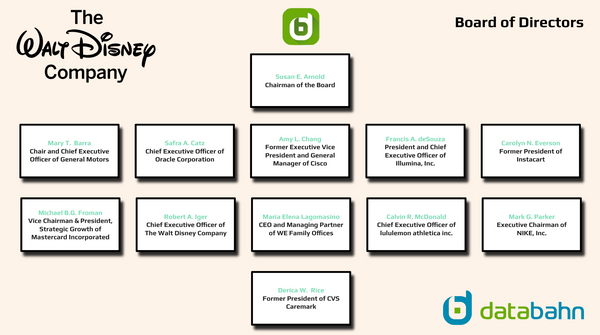Disney Organizational Structure in 2025
Disney Organizational Structure in 2025

The Walt Disney Company
NYSE: DIS
500 South Buena Vista Street
Burbank, CA 91521
United States
Main Phone: (818) 560-1000
Website: https://www.thewaltdisneycompany.com
Sector(s): Communication Services
Industry: Entertainment
Full Time Employees: 171,600
Annual Revenues: $86.98 Billion USD
Fiscal Year End: October 1, 2023
CEO: Robert Iger
Fortune 500 Rank: #48 (2023)
What does the Disney organization look like under Bob Iger's return to the CEO position?
Disney is one of the world's most recognizable and successful media and entertainment companies, known for its iconic theme parks, blockbuster films, and beloved characters. In 2023, Robert Iger took over as the CEO of Disney, succeeding Bob Chapek. With Iger at the helm, the company's organizational structure has undergone significant changes to adapt to the rapidly evolving media landscape.
One of the most notable changes under Iger's leadership has been the consolidation of Disney's various business segments into a more streamlined structure. Prior to Iger's tenure, the company was organized into several distinct divisions, including the Walt Disney Studios, Parks and Resorts, and Media Networks. Under Iger, these divisions were merged into a single, unified business unit, with the goal of increasing collaboration and efficiency across the company.
In addition to consolidating the company's business segments, Iger also placed a renewed emphasis on digital media and streaming services. In recent years, the entertainment industry has seen a rapid shift towards streaming platforms, and Disney has been quick to adapt to this trend. Under Iger's leadership, the company has invested heavily in its streaming service, Disney+, which has quickly become one of the most popular streaming platforms in the world. The organization also invested in Hulu, a streaming service which provides a distinct audience to Disney.
Another key aspect of Disney's organizational structure under Iger has been a renewed focus on creativity and innovation. Iger has placed a high priority on fostering a culture of creativity and experimentation within the company, encouraging employees to think outside the box and take risks. This has led to the development of new and exciting projects, such as the highly successful Star Wars franchise and the upcoming Disney+ series "The Book of Boba Fett"
Iger has also made a concerted effort to strengthen Disney's relationships with its various partners and stakeholders. This has included forming strategic partnerships with other media companies, as well as engaging with the company's employees, customers, and shareholders. By building strong relationships with these stakeholders, Iger has been able to better understand and respond to their needs, which has helped to drive the company's growth and success.
Finally, Iger has placed a high priority on sustainability and corporate social responsibility. Under his leadership, Disney has made significant investments in renewable energy, environmentally friendly initiatives, and programs to support local communities. These efforts have helped to build a positive reputation for the company and have also helped to attract and retain top talent.
In conclusion, under Robert Iger's leadership, Disney's organizational structure has undergone significant changes to adapt to the rapidly evolving media landscape. The company has consolidated its business segments, placed a renewed emphasis on digital media and streaming services, fostered a culture of creativity and innovation, strengthened relationships with partners and stakeholders, and made significant investments in sustainability and corporate social responsibility. These efforts have helped to position Disney as a leading player in the entertainment industry and have set the company up for continued success in the years to come.
What do the Disney Org Charts look like in 2025?
Disney Org Chart - Executive Leadership

What are Disney's corporate growth strategies?
Disney's corporate growth strategies have evolved over time, but some key elements have remained consistent. Some of Disney's main growth strategies include:
-
Diversifying its revenue streams: Disney has traditionally relied heavily on its theme parks and media networks for revenue, but in recent years the company has been focused on expanding its presence in new areas such as streaming media and direct-to-consumer offerings.
-
Investing in content: Disney has a strong portfolio of brands and franchises, such as Marvel, Star Wars, and Pixar, which it has leveraged to produce a wide range of content across various platforms, including movies, TV shows, and theme park attractions.
-
Acquisitions and partnerships: Disney has made a number of strategic acquisitions and partnerships over the years, including the acquisition of Marvel, Lucasfilm (Star Wars), and 21st Century Fox, which have helped the company expand its content offerings and reach new audiences.
-
Expanding internationally: Disney has a significant global presence and continues to expand its operations in international markets through the opening of new theme parks and the establishment of partnerships with local media companies.
-
Innovation in technology: Disney has been investing in technology to drive their growth in their traditional business like theme park, but also to enhance and expand their streaming services, virtual reality, augmented reality and other digital experiences for their customers.
These are some of the key strategies that Disney has been focusing on to drive growth. However, it's important to note that the company's strategies and initiatives may change over time based on market conditions and other factors.
About databahn
Established in 2015, databahn is an account intelligence company headquartered in Nashua, New Hampshire. The research team specializes in delivering comprehensive and up-to-date insights on Fortune 1000 and Global 2000 companies. databahn offers a range of information services, including deep dive company profiles, financial insights, news updates, competitive analysis, org charts and accurate contact information. databahn's account intelligence is meticulously curated, enabling businesses to make informed decisions, identify sales opportunities, and gain a competitive edge. With the focus on accuracy, completeness, and timeliness, databahn serves as a valuable resource for sales and marketing professionals and other industries that require reliable and actionable insights on large & complex enterprise companies.
Fill out the form below to request to see a sneak peek at the Disney Org Chart & Sales Intelligence Report.

